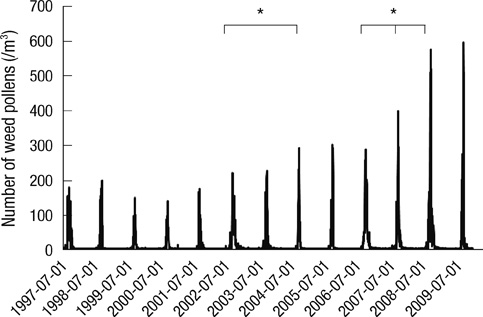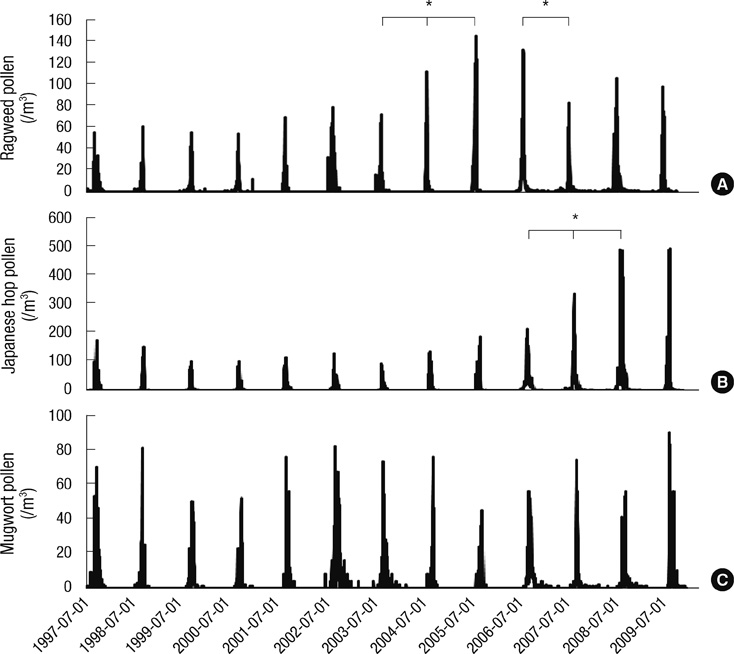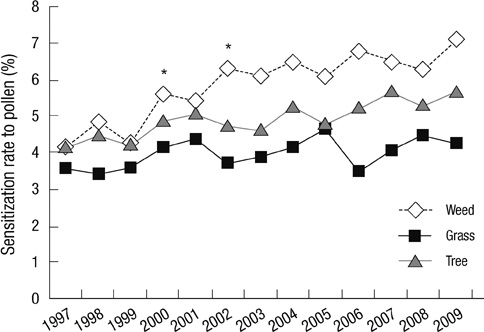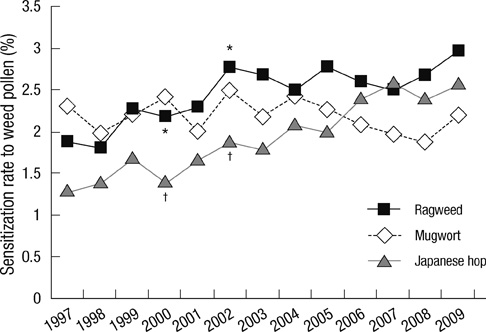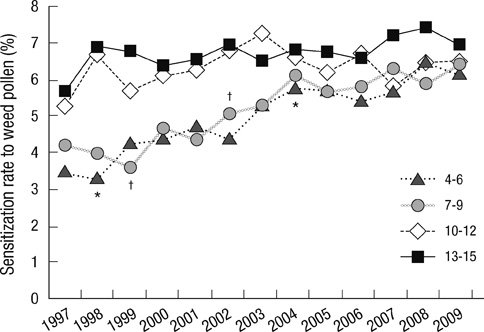Changes in Sensitization Rate to Weed Allergens in Children with Increased Weeds Pollen Counts in Seoul Metropolitan Area
- Affiliations
-
- 1Department of Pediatrics, Hanyang University College of Medicine, Seoul, Korea. jaewonoh@hanyang.ac.kr
- 2Department of Pediatrics, Busan St. Maria Hospital, Busan, Korea.
- 3Department of Pediatrics, Daegu Fatima Hospital, Daegu, Korea.
- 4Department of Pediatrics, Gwangju Veteran's Hospital, Gwangju, Korea.
- 5Department of Pediatrics, Asan Medical Center, University of Ulsan College of Medicine, Gangneung, Korea.
- 6Department of Pediatrics, Jeonju Jesus Hospital, Jeonju, Korea.
- 7Department of Pediatrics, Kangdong Sacred Heart Hospital, Hallym University College of Medicine, Seoul, Korea.
- 8Applied Meteorology Research Laboratory, National Institute of Meteorological Research, Seoul, Korea.
- KMID: 2157893
- DOI: http://doi.org/10.3346/jkms.2012.27.4.350
Abstract
- The prevalence of allergic diseases in children has increased for several decades. We evaluated the correlation between pollen count of weeds and their sensitization rate in Seoul, 1997-2009. Airborne particles carrying allergens were collected daily from 3 stations around Seoul. Skin prick tests to pollen were performed on children with allergic diseases. Ragweed pollen gradually increased between 1999 and 2005, decreased after 2005 and plateaued until 2009 (peak counts, 67 in 2003, 145 in 2005 and 83 grains/m3/day in 2007). Japanese hop pollen increased between 2002 and 2009 (peak counts, 212 in 2006 and 492 grains/m3/day in 2009). Sensitization rates to weed pollen, especially ragweed and Japanese hop in children with allergic diseases, increased annually (ragweed, 2.2% in 2000 and 2.8% in 2002; Japanese hop, 1.4% in 2000 and 1.9% in 2002). The age for sensitization to pollen gradually became younger since 2000 (4 to 6 yr of age, 3.5% in 1997 and 6.2% in 2009; 7 to 9 yr of age, 4.2% in 1997 and 6.4% in 2009). In conclusion, sensitization rates for weed pollens increase in Korean children given increasing pollen counts of ragweed and Japanese hop.
Keyword
MeSH Terms
Figure
Cited by 9 articles
-
A Six-Year Study on the Changes in Airborne Pollen Counts and Skin Positivity Rates in Korea: 2008–2013
Hye Jung Park, Jae-Hyun Lee, Kyung Hee Park, Kyu Rang Kim, Mae Ja Han, Hosoeng Choe, Jae-Won Oh, Chein-Soo Hong
Yonsei Med J. 2016;57(3):714-720. doi: 10.3349/ymj.2016.57.3.714.Clinical diagnostic guidelines for allergic rhinitis: diagnosis
Young Hyo Kim, Hyeon-Jong Yang, Jeong-Hee Choi, Dong-Kyu Kim, Young Yoo, Bora Lee, Mi-Ae Kim, Bong-Seong Kim, Won-Young Kim, Jeong Hee Kim, Yang Park, So Yeon Park, Woo Yong Bae, Keejae Song, Min-Suk Yang, Sang Min Lee, Young-Mok Lee, Hyun Jong Lee, Jae-Hong Cho, Hye Mi Jee, Young-Il Koh,
J Korean Med Assoc. 2017;60(1):81-88. doi: 10.5124/jkma.2017.60.1.81.Sensitization rates to inhalant allergens in children and adolescents of Incheon and Asan area and the relationship between polysensitization and prevalence of allergic diseases
Hyung Young Kim, Ju-Hee Seo, Young-Ho Jung, Eun Lee, Song I Yang, Mina Ha, Ho-Jang Kwon, Jong-Han Lim, Hwan-Chul Kim, Kee Jae Lee, Inho Park, Young-Wook Lim, Jong-Hyun Lee, Yeni Kim, Youn-Hee Choi, Jeesuk Yu, Jeongseon Kim, Seung-Do Yu, Bo-Eun Lee, Soo-Jong Hong
Allergy Asthma Respir Dis. 2013;1(1):41-49. doi: 10.4168/aard.2013.1.1.41.Identification of IgE binding components of two major weed pollens, ragweed and mugwort
Moon-Gyung Yoon, Mi-Ae Kim, Hyun-Jung Jin, Yoo-Seob Shin, Hae-Sim Park
Allergy Asthma Respir Dis. 2014;2(5):337-343. doi: 10.4168/aard.2014.2.5.337.Evaluation of the association of vegetation of allergenic plants and pollinosis with meteorological changes
Joo-Hwa Kim, Jae-Won Oh, Ha-Baik Lee, Seong-Won Kim, Hai-Lee Chung, Myung-Hee Kook, Kang-Seo Park, Bong-Seong Kim, Ja-Kyung Kim, Dong-Jin Lee, Won-Ki Paik, Kyu-Rang Kim, Hey-Lim Lee, Young-Jin Choi, Seung-Do Yu, Jeong-Hwa Kim, Yong-Seong Cho
Allergy Asthma Respir Dis. 2014;2(1):48-58. doi: 10.4168/aard.2014.2.1.48.The correlation between allergy sensitization rate in pediatric and aerobiological study for airborne pollen in Busan for 15 years
Myong Soon Sung, Yong-Jin Park, Geun Hwa Park, Jae Won Oh, Sung Won Kim
Allergy Asthma Respir Dis. 2014;2(1):38-47. doi: 10.4168/aard.2014.2.1.38.Changes of aeroallergen sensitization in children with asthma or allergic rhinitis from a tertiary referral hospital in Seoul over 10 years
Young-Ho Jung, Keum-Hee Hwang, Song-I Yang, En Lee, Kyung-Hee Kim, Min-Ju Kim, Geun-Mi Park, Ju-Hee Seo, Hyung Young Kim, Jinho Yu, Soo-Jong Hong
Allergy Asthma Respir Dis. 2014;2(2):97-102. doi: 10.4168/aard.2014.2.2.97.Evaluation of the association between pollen count and the outbreak of allergic disease
Ha-Na Kang, Hey Suk Yun, Young-Jin Choi, Jae-Won Oh, Ui-Young Min, Yoon-Sook Heo, Young-Seop Lee, Mijin Kim, Kyu Rang Kim, Baek-Jo Kim
Allergy Asthma Respir Dis. 2016;4(6):415-422. doi: 10.4168/aard.2016.4.6.415.Chamber and Field Studies demonstrate Differential Amb a 1 Contents in Common Ragweed Depending on CO2 Levels
Young-Jin Choi, Hae-Rin Oh, Jae-Won Oh, Kyu Rang Kim, Mi-Jin Kim, Baek-Jo Kim, Won-Gi Baek
Allergy Asthma Immunol Res. 2018;10(3):278-282. doi: 10.4168/aair.2018.10.3.278.
Reference
-
1. Asher MI, Montefort S, Björkstén B, Lai CK, Strachan DP, Weiland SK, Williams H. ISAAC Phase Three Study Group. Worldwide time trends in the prevalence of symptoms of asthma, allergic rhinoconjunctivitis, and eczema in childhood: ISAAC Phases One and Three repeat multicountry cross-sectional surveys. Lancet. 2006. 368:733–743.2. Eder W, Ege MJ, von Mutius E. The asthma epidemic. N Engl J Med. 2006. 355:2226–2235.3. Hong SJ, Ahn KM, Lee SY, Kim KE. The prevalences of asthma and allergic diseases in Korean children. Korean J Pediatr. 2008. 51:343–350.4. Jee HM, Kim KW, Kim CS, Sohn MH, Shin DC, Kim KE. Prevalence of asthma, rhinitis and eczema in Korean children using the International Study Of Asthma and Allergies In Childhood (ISAAC) questionnaires. Pediatr Allergy Respir Dis. 2009. 19:165–172.5. Beggs PJ. Impacts of climate change on aeroallergens: past and future. Clin Exp Allergy. 2004. 34:1507–1513.6. Bernard SM, Samet JM, Grambsch A, Ebi KL, Romieu I. The potential impacts of climate variability and change on air pollution-related health effects in the United States. Environ Health Perspect. 2001. 109:199–209.7. D'Amato G, Liccardi G, D'Amato M, Holgate S. Environmental risk factors and allergic bronchial asthma. Clin Exp Allergy. 2005. 35:1113–1124.8. Frenguelli G. Interactions between climatic changes and allergenic plants. Monaldi Arch Chest Dis. 2002. 57:141–143.9. Namork E, Johansen BV, Løvik M. Detection of allergens adsorbed to ambient air particles collected in four European cities. Toxicol Lett. 2006. 165:71–78.10. Oh JW, Lee HB, Kang IJ, Kim SW, Park KS, Kook MH, Kim BS, Baek HS, Kim JH, Kim JK, Lee DJ, Kim KR, Choi YJ. The revised edition of Korean calendar for allergenic pollens. Allergy Asthma Immunol Res. 2012. 4:5–11.11. Knox RB, Suphioglu C, Taylor P, Desai R, Watson HC, Peng JL, Bursill LA. Major grass pollen allergen Lol p 1 binds to diesel exhaust particles: implications for asthma and air pollution. Clin Exp Allergy. 1997. 27:246–251.12. D'Amato G, Cecchi L. Effects of climate change on environmental factors in respiratory allergic diseases. Clin Exp Allergy. 2008. 38:1264–1274.13. Ayres JG, Forsberg B, Annesi-Maesano I, Dey R, Ebi KL, Helms PJ, Medina-Ramón M, Windt M, Forastiere F. Environment and Health Committee of the European Respiratory Society. Climate change and respiratory disease: European Respiratory Society position statement. Eur Respir J. 2009. 34:295–302.14. Park HS, Nahm DH, Suh CH, Lee SM, Choi SY, Jung KS, Lee SY, Park K. Evidence of Hop Japanese pollinosis in Korea: IgE sensitization and identification of allergenic components. J Allergy Clin Immunol. 1997. 100:475–479.15. Hirschwehr R, Heppner C, Spitzauer S, Sperr WR, Valent P, Berger U, Horak F, Jäger S, Kraft D, Valenta R. Identification of common allergenic structures in mugwort and ragweed pollen. J Allergy Clin Immunol. 1998. 101:196–206.16. Ziska LH, Gebhard DE, Frenz DA, Faulkner S, Singer BD, Straka JG. Cities as harbingers of climate change: common ragweed, urbanization, and public health. J Allergy Clin Immunol. 2003. 111:290–295.17. Fitter AH, Fitter RS. Rapid changes in flowering time in British plants. Science. 2002. 296:1689–1691.18. Singer BD, Ziska LH, Frenz DA, Gebhard DE, Straka JG. Increasing Amb a 1 content in common ragweed (Ambrosia artemisiifolia) pollen as a function of rising atmospheric CO2 concentration. Funct Plant Biol. 2005. 32:667–670.19. Environment RoKMo. List of environmentally harmful animals and plants in Korea. 2009. ME Publishing (Korean);95–102. ISBN 11-1480000-001000-01.20. Oh JW, Lee HR, Kim JS, Lee KI, Kang YJ, Kim SW, Kook MH, Kang HY, Kim JS, Lee MH, Lee HB, Kim KE, Pyun BY, Lee SI, Han MJ. Aerobiological study of pollen and mold in the 10 states of Korea. Pediatr Allergy Respir Dis. 2000. 10:22–33.21. Ziska LH, Caulfield FA. Rising CO2 and pollen production of common ragweed (Ambrosia artemisiifolia L.), a known allergy-inducing species: implications for public health. Aust J Plant Physiol. 2000. 27:893–898.22. Ackermann-Liebrich U, Schindler C, Frei P, Probst-Hensch NM, Imboden M, Gemperli A, Rochat T, Schmid-Grendemeier P, Bircher AJ. Sensitisation to Ambrosia in Switzerland: a public health threat on the wait. Swiss Med Wkly. 2009. 139:70–75.23. Frenz DA. Interpreting atmospheric pollen counts for use in clinical allergy: allergic symptomology. Ann Allergy Asthma Immunol. 2001. 86:150–157.24. Ehara K. Comparative morphological studies of the hop (Humulus lupulus L.) and the Japanese hop (H. japonicus Sieb. et Zucc.) Part I. J Fac Agric Kyushu Univ. 1955. 10:209–232.25. Cronk QC, Fuller JL. Plant invaders: the threat to natural ecosystems. 1995. London: Chapman & Hall;241.26. Wittenberg R, Cock MJW. Invasive alien species. How to address one of the greatest threats to biodiversity: a toolkit of best prevention and management practices. 2001. Oxon: CAB International.
- Full Text Links
- Actions
-
Cited
- CITED
-
- Close
- Share
- Similar articles
-
- Change of causative inhalant allergens in respiratory allergic patients in Chungbuk district
- Change of Inhalant Allergen Sensitization in Children with Allergic Respiratory Diseases during Recent 10 Years
- The Correlation between Increased Sensitization Rate to Weeds in Children and the Annual Increase in Weed Pollen in Korea
- Regional Difference of Causative Pollen in Children with Allergic Rhinitis
- Trends of Sensitization to Inhalant Allergens in Korean Children Over the Last 10 Years

